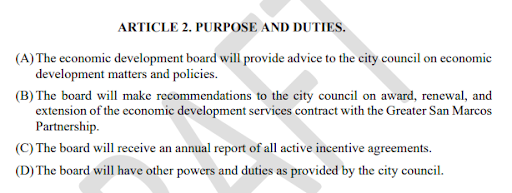Citizen Comment: the big topic is the humane pet shop ordinance, which is going to be coming back around, in January. We saw this last year, with the Pick-a-Pet Problem. It’s still a problem! Stay tuned.
Item 16: Meet Mystic Canyon:

The developers have agreed to run some sewage lines in a way that preserves a few heritage trees.
Tuesday’s item was genuinely no big deal, but I figured we could have a brief explainer on Mystic Canyon, especially in light of the Edwards Aquifer Recharge Zone discussion (which is coming in the last part of the meeting).
So, Mystic Canyon? It was approved in 2018. Here’s how the vote went:

(Pre-covid, the council members used to vote on little Jeopardy-click devices, so they couldn’t copy off each other’s answers.) So both your candidates for mayor voted yes, as did Saul.
And in fact, both Max Baker and Mark Gleason were on P&Z together at the time, so we also know how they voted (although P&Z did not use the little Jeopardy-clickers).
The P&Z Vote: Mystic Canyon should exist?
Yes: Mark Gleason (and also Kate McCarty, Lee Porterfield, and Jim Garber)
No: Max Baker (and also Angie Ramirez and Betseygail Rand)
In case anyone from the city staff reads this: your website lists Matt Mendoza as having voted at that meeting, which is nonsense because he only joined P&Z in 2022:

But here, you can watch the video – it’s Matthew Havriland that was on the committee back then. Someone fix this, stat! (The votes look screwy because that is a motion to deny. So “For” means deny, and “Against” means pro-development.)
It’s not the sprawliest sprawl, but we still shouldn’t be developing over the recharge zone. More on the topic of the Edwards Aquifer to come.
…..
Item 15: I have no idea what’s going on here, for two reasons:
- Clearly there’s a lot of backstory. Is this an Executive Session Secret?
- The item is an approval to say San Marcos does not consent, and then we denied it.
Here’s the actual item:

We denied this by a vote of 6-0. So the Hillert Tract gets their Crystal Clear water after all?
My guess is that this was dealt with in Executive Session:


Sounds like someone got in trouble! OooooOOO!
So: what’s the Hillert Tract? I went down a short rabbit hole. We acquired it in 2008. It shows up in Executive Session roughly yearly. It seems there’s some drama going on with Martindale. Finally I found a map, from 2014:

So it’s sort of next to Redwood, and next to the currently-controversial Riverbend development.
Side note: why are we drawing I-35 almost horizontally?! Check out the little compass in the top left. I mean, if that’s how you like to look at the world, knock yourself out.
….
Item 20: This one is really important! We have a board called the Economic Development Board of San Marcos, or EDSM.
Here’s what EDSM does:

So the EDSM is supposed to look out for the best interests of the city. Then the city turns around and contracts things out to the Greater San Marcos Partnership, or GSMP. GSMP is a nonprofit that wants to grow and groom the business community of San Marcos. You can imagine – or at least I can – that what’ s best for the business community is not always aligned with what’s best for San Marcos.
Last spring, Max pointed out that it is a conflict of interest for GSMP members to serve on EDSM. If they’re on EDSM, they’re supposed to advise council on what’s best for San Marcos. But then, whatever they approve goes straight to GSMP. It’s not a great look.
Now, GSMP is entitled to one non-voting representative on EDSM. The problem is people serving in at-large seats on EDSM who also happen to serve on GSMP. Max also made the point that this reduces the number of EDSM seats available for the rest of the community.
The issue got sent to committee, and the committee has agreed. So tonight, they amended EDSM to say that members can’t also serve on GSMP. This is great!
The business community is still relatively small, and we’re still drawing on the same pool for both committees, so clearly everyone still knows each other. But one key to having an ethically-run city is not to create opportunities for temptation. It’s good to put some daylight between these two groups.
Also, this is a great example by Max of the kind of small-but-good thing that progressives do differently at the local level. Put activists on city council, and they’ll do good things.

